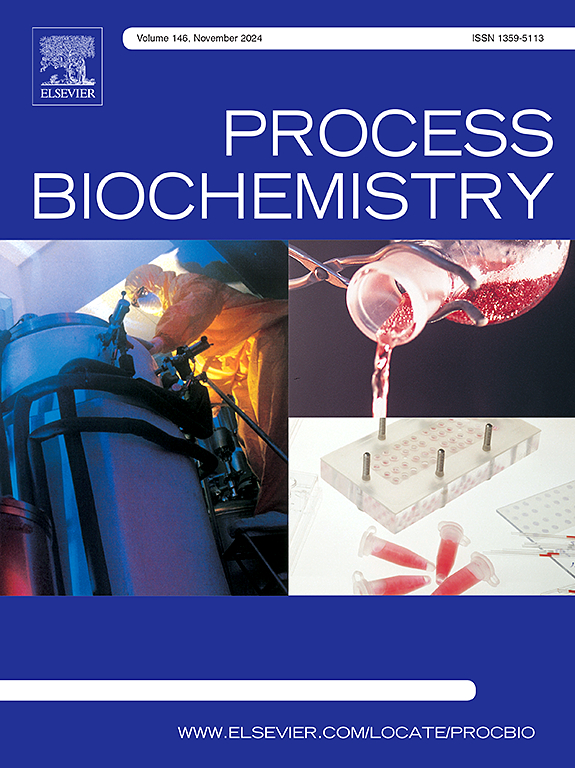Integration of 2,3-butanediol production and extraction of active components from Chinese herbs by Bacillus licheniformis and evaluation of fermentation products in vitro
IF 3.7
3区 生物学
Q2 BIOCHEMISTRY & MOLECULAR BIOLOGY
引用次数: 0
Abstract
The aim of this work was to develop an integrated process of 2,3-butanediol production and extraction of active components from Chinese herbs via fermentation, and evaluate their potential as cosmetic ingredients in vitro. A GRAS strain DL2–2 of Bacillus licheniformis was isolated and the fermentation medium was optimized using the ingredients that could be used in cosmetics. Four types of Chinese herbs were added solely or in combination into the fermentation medium to perform 2,3-butanediol production and active components extraction simultaneously. The release of polysaccharides and flavonoids was promoted, and the antioxidant, whitening and antibacterial abilities were improved. The highest antioxidant and antibacterial activity was obtained from the ferment filtrate of Dendrobium devonianum and Gastrodia elata f. glauca, resulting from the highest contents of flavonoids (0.44 g/L) and polyphenols (0.31 g/L), and 42.2 g/L 2,3-butanediol was also produced. The highest polysaccharide concentration was obtained from the ferment filtrate containing Polygonatum kingianum, which exhibited the highest inhibitory effect on tyrosinase (65 %), similar to that of 1 g/L arbutin. Therefore, the filtrate of 2,3-butanediol-Chinese herbal fermentation broth is promising as an ingredient in the production of natural high-value cosmetics.
地衣芽孢杆菌生产 2,3-丁二醇与提取中草药活性成分的整合及发酵产物的体外评价
这项工作的目的是开发一种通过发酵生产 2,3-丁二醇和提取中草药活性成分的综合工艺,并在体外评估其作为化妆品成分的潜力。研究人员分离了地衣芽孢杆菌的 GRAS 菌株 DL2-2,并利用可用于化妆品的成分对发酵培养基进行了优化。将四种中草药单独或混合加入发酵培养基中,同时进行 2,3-丁二醇的生产和活性成分的提取。结果表明,2,3-丁二醇能促进多糖和黄酮类化合物的释放,提高抗氧化、美白和抗菌能力。铁皮石斛和天麻的发酵滤液中黄酮类化合物(0.44 克/升)和多酚类化合物(0.31 克/升)含量最高,抗氧化和抗菌活性也最高,同时还产生了 42.2 克/升的 2,3-丁二醇。含有何首乌的发酵滤液中多糖浓度最高,对酪氨酸酶的抑制作用最强(65%),与 1 g/L 熊果苷的抑制作用相似。因此,2,3-丁二醇-中草药发酵液滤液有望成为生产天然高价值化妆品的原料。
本文章由计算机程序翻译,如有差异,请以英文原文为准。
求助全文
约1分钟内获得全文
求助全文
来源期刊

Process Biochemistry
生物-工程:化工
CiteScore
8.30
自引率
4.50%
发文量
374
审稿时长
53 days
期刊介绍:
Process Biochemistry is an application-orientated research journal devoted to reporting advances with originality and novelty, in the science and technology of the processes involving bioactive molecules and living organisms. These processes concern the production of useful metabolites or materials, or the removal of toxic compounds using tools and methods of current biology and engineering. Its main areas of interest include novel bioprocesses and enabling technologies (such as nanobiotechnology, tissue engineering, directed evolution, metabolic engineering, systems biology, and synthetic biology) applicable in food (nutraceutical), healthcare (medical, pharmaceutical, cosmetic), energy (biofuels), environmental, and biorefinery industries and their underlying biological and engineering principles.
 求助内容:
求助内容: 应助结果提醒方式:
应助结果提醒方式:


